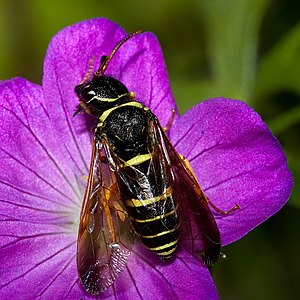Megalodontesidae
| Megalodontesidae | ||||||||||
|---|---|---|---|---|---|---|---|---|---|---|

Megalodontes sp. |
||||||||||
| Systematics | ||||||||||
|
||||||||||
| Scientific name | ||||||||||
| Megalodontesidae | ||||||||||
| ( Konow ), 1897 |
The Megalodontesidae are a small family of plant wasps that are closely related to the spider sawfly . Six of the approximately 50 species are common in Central Europe.
features
They are medium-sized plant wasps (body length about 10 to 14 mm) that are somewhat flattened (dorsoventrally). The most important difference to the spotted sawfly is the construction of the antennae , the flagellar limbs of which are somewhat tooth-shaped ("sawed") on the outside in both sexes. The well-developed mouth limbs, which can reach the length of the head capsule, stand out on the head. The maxilla and labium are fused into an expandable, pillow-like structure that is used to absorb pollen and nectar when visiting flowers. The pronotum is large on the trunk and straight at the back. The first tergite of the abdomen is shortened in the middle, so that an oval, unsclerotized zone remains free when the abdomen is angled. The second tergite is undivided (in contrast to the spotted sawfly). The ovipositor of the female forms a saw-blade-like structure that hardly protrudes above the tip of the abdomen when at rest. The animals are almost always drawn in black and yellow with clear wings that are tinted brown in sections and, at first glance, look astonishingly similar to wasps .
Larvae
The larvae are also similar to those of the spider sawfly. Like these, they have three pairs of well-formed thoracic legs, but no pseudopods on the abdomen . There are often two short appendages at the top of the abdomen. The long, seven- to eight-segment antennae on the sclerotized head capsule are noticeable. The larvae live socially in web nests spun together on their host plants. Unlike the spotted sawfly, these are not woody plants, but herbaceous species.
Way of life
The adults of all species are flower visitors. In addition to the umbelliferae , which are also used by the larvae, some species seem to show a striking preference for yellow-colored flowers. The adults' flight time is in summer (June to August). The larvae live in webs on their food plants; in the European species these are exclusively umbelliferous plants of the genera Haarstrang ( Peucedanum ), laser herbs ( Laserpitium ), medicinal herbs ( Seseli or Libanotis ). Like their host species, they live in steppe-like habitats, especially poor and dry grasslands on soils rich in alkaline or heat-favored fringes and forest edges. In most Central Asian species, however, the nutrient plant is unknown.
distribution
The species of the family occur in Central and Southern Europe , north to England , in the entire Mediterranean area and from here east to Central Asia . They are rare in Central Europe and absent in most of Northern Germany. The species Megalodontes cephalotes (syn. Megalodontes klugi ) occurs scattered in southern Germany, to the north to the eastern Harz foreland ( Kyffhäuser ) and to northern Hesse. All other species have only been identified sporadically and marginally.
Taxonomy and systematics
The family was called Megalodontidae until 1996. Due to inadmissible homonymy with an extinct family of mussels (cf. Megalodon abbreviatus ), the name was changed to Megalodontesidae. The family, together with the spotted sawfly (Pamphilidae), forms the superfamily Pamphiloidea, also called Megalodontoidea by other authors. There is no doubt about this sister group relationship.
Four genera are assigned to this family, of which only the type genus Megalodontes is more widespread. All species occurring in Europe belong to it.
The following species have been found in Germany:
- Megalodontes cephalotes ( Fabricius , 1871)
- Megalodontes fabricii ( Leach , 1817)
- Megalodontes plagiocephalus ( Fabricius , 1804)
- Megalodontes panzeri ( Leach , 1817)
- Megalodontes thor Taeger , 2002
The German species can be identified with the "Excursion fauna of Germany" (Volume 2).
Another species occurs in Austria:
- Megalodontes flavicornis ( Klug , 1824)
swell
- RB Benson: Handbook for the identification of British insects. Vol IV: Hymenoptera. 2. Symphyta Section a. Published by the Royal Entomological Society of London, 1951.
- Andreas Taeger, Ewald Altenhofer, Stephan M. Blank, Ewald Jansen, Manfred Kraus, Hubert Pschorn-Walcher, Carsten Ritzau: Comments on the biology, distribution and endangerment of plant wasps in Germany (Hymenoptera, Symphyta). In: A. Taeger, SM Blank (ed.): Plant wasps in Germany (Hymenoptera, Symphyta). Annotated inventory. Goecke & Evers, Keltern 1998, ISBN 3-931374-13-0 .
- Gleb Sergeevitch Medvedev: Keys to the insects of the European part of the USSR .: Hymenoptera: Symphyta. Volume 3, Part 6. Brill Publishers, 1994, ISBN 90-04-09561-6 .
Individual evidence
- ^ Herbert Weiffenbach (1985): Symphyta (Hymenoptera) of southern Lower Saxony, northern and central Hesse. Communications of the Munich Entomological Society 75, pp. 5-44.
- ↑ International Commission On Zoological Nomenclature (1996): Opinion 1829. Megalodontidae Konow, 1897 (Insecta, Hymenoptera): spelling emended to Megalodontesidae, so removing the homonymy with Megalodontidae Morris & Lycett, 1853 (Mollusca, Bivalvia). Bulletin of Zoological Nomenclature 53 (1), pp. 66-67.
- ^ Bernhard Klausnitzer, Hans-Joachim Hannemann, Konrad Senglaub, Erwin Stresemann: Stresemann excursion fauna of Germany. Volume 2: Invertebrates: Insects. 11th edition. Springer Verlag, 2011, ISBN 978-3-8274-2451-8 .